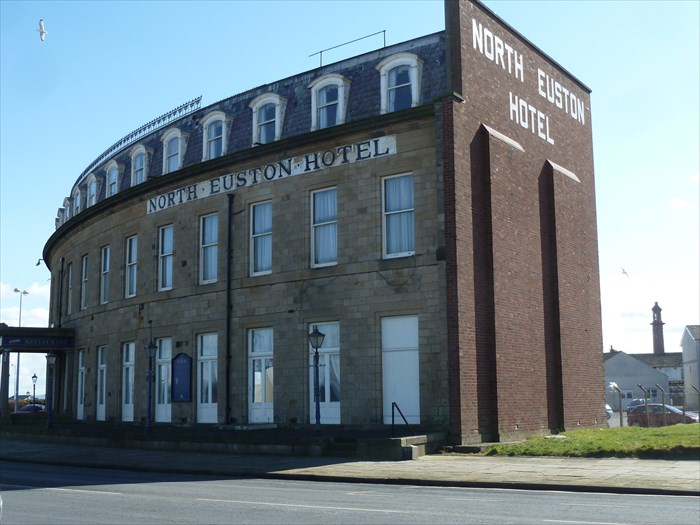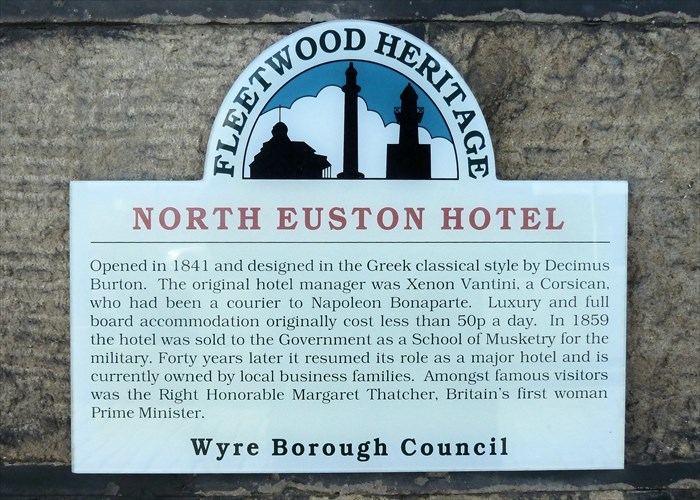
This large building built in a near semi-circle dominates the north side of the Promenade in the historic fishing town of Fleetwood, as it faces the see. It's glory days are long past, and for a period it was sold to the government and operated for six years as the School of Musketry, although eventually returning to use as a hotel, and today thrives as a modern venue for functions, dining, and lodging as the new
North Euston Hotel. After extensive renovation, it was honored with the Wyre Conservation Award, Premier, in 1993.

NORTH EUSTON HOTEL
Opened in 1841 and designed in the Greek classical style by Decimus Burton. The original hotel manager was Xenon Bonaparte. Luxury and full board accommodation originally cost less than 50p a day. In 1859 the hotel was sold to the Government as a School of Musketry for the military. Forty years later it resumed its role as a major hotel and is currently owned by local business families. Amongst famous visitors was the Right Honorable Margaret Thatcher, Britain's first woman Prime Minister.
Wyre Borough Council

WYRE CIVIC CONSERVATION AWARD
PREMIER AWARD 1993
LISTED BUILDING
AS SPONSORED BY
ICI HILLHOUSE & WYRE BOROUGH
The following information is taken for signs along The Esplanade:
When the North Euston Hotel opened its doors in 1841, the place was the talk of Lancashire.
The manager was Xenon Vantini who hailed from Corsica and had been a courier to Napolean Bonaparte. Italian opera house musicians played in the ballroom.
Next door was a building that house sea water baths and had a handsome portico frontage made of stone to match the main hotel building with its graceful curved facade.
It is the finest example in Fleetwood of the work of Decimus Burton, the noted Victorian architect who designed the town.
Rail passengers travelled from London and stayed overnight before catching a steamer to Ardossan on the Clyde to resume their jail journey in Scotland.
When the West Coast rail route was completed, trade at the Euston was damaged. In 1859 it was sold to the Government as part of a major military presence in town.
The School of Musketry saw thousand of troops visit Fleetwood for weapons training. Officers lived in the Euston building and there were wooden huts nearby. In the western part of the town, soldiers lived in huts and tents and the Queen Hotel in Beach Road was built to quench their thirst. There were permanent building too including a guardhouse, a hospital, and an explosives store.
Although the Euston became a hotel again, the military links remained for many years. During World War I a young officer called Wilfred Owen was billeted in nearby Bold Street before returning to the battlefields that took his life. His epic anit-war poems are his memorial.
The following information is from the Wikipedia article on the North Euston Hotel:
"Fleetwood was a 19th-century planned town, developed by local landowner Peter Hesketh-Fleetwood. Inspired by southern English seaside resorts like St Leonards-on-Sea, Hesketh-Fleetwood employed architect Decimus Burton to lay out his new town and design the main buildings.
Burton designed the hotel as a focal point in the town. Construction started in 1840 and it opened the following year. A regatta was held in celebration of the hotel's opening in August 1841. The hotel's first manager was a Corsican man called Xenon Vantini. By the 1850s, a direct rail route to Scotland had been built, ending Hesketh-Fleetwood's hopes of Fleetwood becoming a major transport hub. The town's tourist industry was failing and the North Euston was sold to the government. From 1861–1867 the War Department used it as a School of Musketry. Later, with additional buildings, it was converted into Euston Barracks. In 1898 the North Euston reverted to its original purpose.
The building was designated as a Grade II Heritage Building with the following entry by British Heritage:
The hotel is built of ashlar with slate roofs. It has a curved plan, with a front façade that stretches approximately 900 feet (270 m). The north and south wings have two regular storeys with a mansard roof, and dormers providing accommodation on the third floor. The central portion has three full storeys. The north wing, which faces along The Esplanade, curves almost a full 90 degrees, while the south wing is shorter, curving roughly 45 degrees. At the front of the building there is a porte-cochère (porch) supported by fluted Roman Doric columns.
Another interesting article appears in Mike Higginbottom Interesting Times:
Its name indicates that it was once the northern terminus of the railway from London’s Euston Station, at a time when George Stephenson proclaimed that no locomotive would ever manage the climb over Shap to the Scottish border.
The town of Fleetwood was planned and named by Sir Peter Hesketh Fleetwood (1801-1866) as the transhipment point between the Preston & Wyre Railway, which opened in 1840, and the steamer service to Ardrossan which was connected by rail to Glasgow.
This worked fairly well until what we now call the West Coast Main Line opened over Shap in 1847. By that time Sir Peter Hesketh Fleetwood had gone bankrupt, and though Fleetwood harbour in time served other purposes, its railway remained forever on a branch line from Preston.
The grandly curving hotel was designed by Decimus Burton as part of Fleetwood’s intended holiday resort.
The hotel’s first manager, a Corsican called Zenon Vantini, was responsible for the first railway-station refreshment-room, at Wolverton, and ran the Euston and Victoria Hotels in London.
Opened in 1841, it was eventually bought by the War Department a School of Musketry for Officers, and reopened in 1861 as the Euston Barracks.
Vantini took a lead, in conjunction with the first vicar of Fleetwood, Rev Canon St Vincent Beechey (son of the painter William Beechey), in founding the Northern Church of England School in 1844.
This school later took the name Rossall School after it leased and then bought the Rossall Hall estate from Sir Peter Hesketh Fleetwood.
Sir Peter Hesketh Fleetwood died in such poverty that his estate could not pay for his funeral.